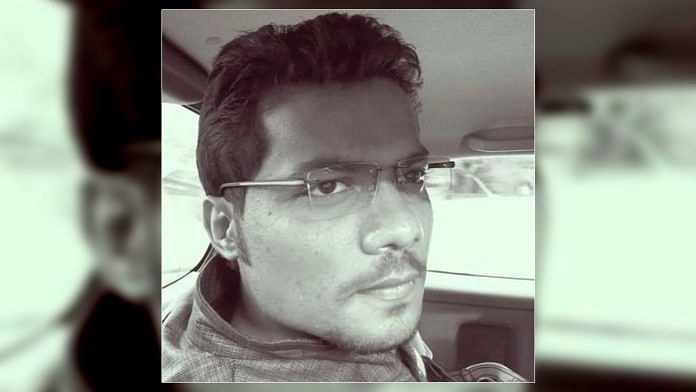New Delhi: The Uttar Pradesh police is struggling to justify its arrest of freelance journalist Prashant Kanojia, since picking him up from his Delhi residence Saturday afternoon for allegedly making “objectionable comments” against Chief Minister Yogi Adityanath.
The police had initially lodged an FIR against Kanojia under Section 500 of the Indian Penal Code (IPC) and Section 66 of the Information Technology Act for a post he shared about a woman wanting to marry the chief minister.
The woman, seen to be speaking to various TV channels, claimed in the video that she had been conversing with the CM for a long time over video chat, and now wanted to know if he was willing to marry her.
Terming the post as an attempt to the “malign the image of the chief minister”, the UP police slapped the two charges against Kanojia, none of which can justify his arrest.
Section 500 criminalises defamation. It is, however, a non-cognisable offence, which means that the police could not have taken direct cognisance of it by registering the FIR. For such cases, the complainant (the CM in this case) is required to file a complaint before a magistrate and an arrest warrant would have to be issued following that. An arrest without a warrant, as in Kanojia’s case, can only be made in relation to cognisable offences.
On the other hand, Section 66 deals with fraudulently or dishonestly damaging a computer system. The provision clearly does not apply in the case, as the FIR states that the complaint relates to Kanojia’s “Twitter social media”. So while Section 66 is a cognisable offence, the police could not have arrested him on this ground as well.
Backlash prompts cops to add further sections
Faced with public backlash and outrage, the police then issued a press release last evening, claiming that Kanojia violated Sections 500 and 505 of the Indian Penal Code, along with Section 67 of the IT Act. This release also claimed that through his post, Kanojia made “obscene comments” and “spread rumours” on social media.
The release added that Kanojia has accepted his crime after “strict interrogation”.
This face-saving exercise, however, also seems to have backfired. For one, these provisions cannot be retrospectively applied to the arrest, which was made on the basis of the FIR. And even if this was possible, the newly added provisions do not help the police’s case in any way.
Section 505 IPC deals with “public mischief” and largely criminalises making, publishing or circulating any statement, rumour or report which might disturb public order or tranquility. Section 67 IT Act punishes publishing or transmitting obscene material in electronic form. One look at the video would go to show that neither were the woman’s claims capable of disturbing public order nor were they obscene.
With none of the legal provisions actually seeming to have been violated by Kanojia, the internet has been abuzz with appeals to release him. The hashtag #ReleasePrashantKanojia has been trending ever since. As for Kanojia, he will have to spend his second night in jail as any relief for him can only come as early as Monday.
Also read: Editors Guild slams arrest of journalist Prashant Kanojia, Nation TV head & editor




The case warrants Habbis Corpus petetion filed from the journalist side…. Arresting under this section is against IPC and IT act provisions amounts to illegal detention.
Interesting: UP Police struggles to justify the arrest because their coprofessionists are asking justification but Editors guild has no such dilemma as nobody can ask them questions and justifications about their actions. There are many political activists with clear political stand but have the mask of a journalist. Once a person is a journalist, he/she gets cover of editors guild which will blindly protect their brothers and sisters. However, public watches 24×7 and that’s the reason journalists’ credibility has been eroded beyond recovery and they have lost public support forever. Does editors guild really care about public opinion?
Adityanath has the habit of having people arrested for the slightest whim of his. Once he had demonstrators arrested WITHOUT BAIL merely for showing him black flags. This man is going to prove worse than Modi if he ever comes to occupy that chair. The only hope is that even the BJP leaders are wary of him, that’s why he was totally ignored for campaigning during the lok sabha elections.
सार्वजनिक पदों पर बैठे हुए लोगों तथा प्रतिष्ठित लोगों को ब्लैकमेल करने का एक जरिया पत्रकारों के बनने की आशंका को पूरी खबर में नजरअंदाज किया गया है। पत्रकारों की एकता के नाम पर किसी भी कथित पत्रकार के ऊल-जलूल हरकतों को अभिव्यक्ति की आजादी क़रार देना मीडिया के अस्तित्व के लिए खतरनाक है। विश्वसनीयता खोने का डर भी होना चाहिए।
Mishra ji, ek mahila kuchh bayaan de rahi theen, wahi uss patrakaar ne aagey kahaa. Yogi ji ko chahiye thaa uss mahila ko arrest kartey, kya pataa kuchh appreey baaton ki pushtee ho jaati. WHY ARREST THE MESSANGER?
Just a stray thought, from a lay person. What if the apex court were to take suo moto cognisance of this case. It involves fundamental rights, including liberty of a citizen and free speech. It also covers freedom of the press, absent which democracy begins to atrophy. The courts – like other public institutions – cannot be everywhere, all the time. They cannot redress all wrongs. Not all Indian citizens have the financial resources to seek effective legal redress. In a particularly egregious instance, if the apex court invests its power, authority and majesty in favour of an ordinary person who has been wronged, its intervention would be heard like a thunderclap all over the country. So – with profound respect – does its silence.